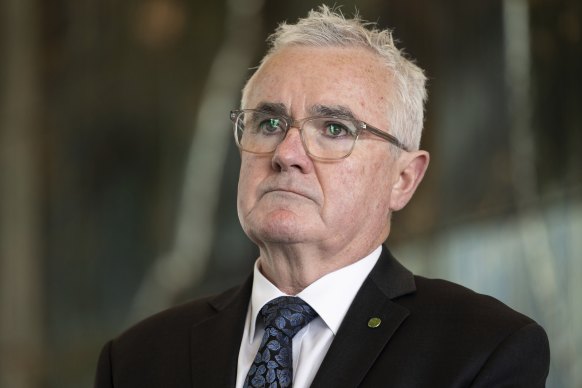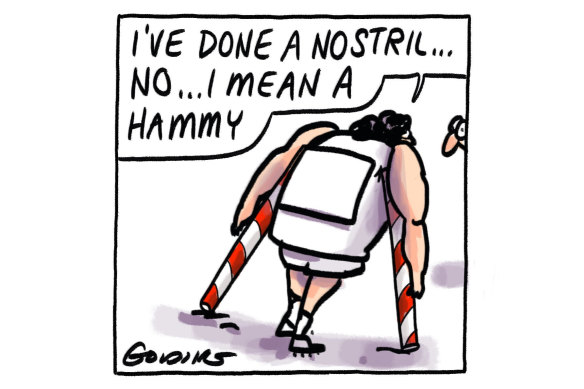By Jake Niall
When an AFL player is prevented from playing – unofficially suspended – due to drug use, we will often be told that the footballer has “personal issues” or has taken time away to deal with mental health problems.
There is a degree of misdirection involved, which arguably has led to the situation in which federal MP Andrew Wilkie has put forward allegations that suggest the AFL covers up drug use by players under its illicit drugs code.

Independent MP Andrew Wilkie.Credit: Alex Ellinghausen.
One allegation, which Wilkie laid out, was that doctors were being asked to say that the player had an injury, rather than that he had a drug issue.
This masthead cannot confirm a specific example in which a player who was falsely said to have a hamstring injury or similar was really on a drug-related absence.
But what is well known is that “personal issues” or “mental health” have been deployed as cover stories for players who have been barred from playing while dealing with a drug issue; clearly, “personal issues” is a wide catch-all, and the overlap between drugs and mental health is sufficient to make that a plausible excuse for the player’s absence.
Note that many players who have personal issues and mental health problems are not dealing with a drug problem; unfortunately, they may be unfairly tarnished by catch-all language.
Here’s a basic sketch of how it unfolds, according to a source with an in-depth understanding of what happens to the player who has a drug issue, but speaking on condition of anonymity in what is a completely confidential process.
The player is placed in the care of his club doctor, who is responsible for his treatment. The doctor has a large degree of autonomy in how the footballer is handled. He can be sent to a clinic, for example, that specialises in drug treatment and tested regularly.
But those tests are “off the books” – the term Wilkie used in parliament – in the sense that they will not result in drug strikes or in public consequences; what happens will be between the player and the club doctor, although the AFL medical officer is also in the loop – he is in an overseeing role, rather than directly involved, and can recommend treatment or testing labs.
The player can be tested, at the behest of the club doctor and with the imprimatur of the AFL’s medical officer.
This masthead cannot confirm a specific example in which a player who was falsely said to have a hamstring injury or similar was really on a drug-related absence.
Jake Niall
The player, if he is continuing to use cocaine or another substance, could be instructed to sit out of games for a period. The AFL’s doctor who runs the illicit drugs code, Dr Peter Harcourt (named by Wilkie in allegations that originated from an ex-Melbourne Football Club doctor), regularly consults the relevant club doctor.
The AFL’s view is that this is simply normal clinical practice: the player has an issue, he deals with the club doctor, who can refer him to drug experts for treatment if necessary. Drugs, thus, are treated as a health problem, not moral failure.
The AFL is unapologetic about the fact that it has effectively condoned or encouraged doctors to test players for illicit drugs with the aim of stopping players from having a positive test on game day – which brings severe repercussions, usually a lengthy suspension under the AFL anti-doping code (same as the WADA code).
But one source familiar with how this regime works noted that the doctor(s) would only organise for the player to be drug tested on Monday or Tuesday – early in the week – and not as late as two or three days before the game.
One reason for the test early in the week was that the tests used by the AFL/club doctor did not have the same level of hyper-sensitivity as those used by Sports Integrity Australia, which could pick up even a tiny presence of the metabolite for cocaine et al.
So, why has the AFL found itself castigated on the floor of federal parliament?
In part, as key people within the game acknowledge, there is a contradiction between a system that is designed to help players – the so-called “medical model” – and a legalistic approach that involves punitive action.
“You can’t throw the book at someone as well as look after them,” said one well-placed competition source with an understanding of the drug system, who was not authorised to speak.
The AFL, meanwhile, has a major brand protection imperative. It does not want to look like it’s soft on or tolerant of footballers openly taking drugs, in the manner of Ben Cousins and others in the past. There’s a pressure to be narcotically correct from governments and sponsors.
The AFL is trying to stave off match-day positives that will result in suspensions (confusing much of the public, as the illicit and WADA drug codes are conflated). It wants to protect the competition image/brand and also to reduce the prevalence and health risks of players using drugs.
Much of what goes on has been known to sections of the media, to the clubs and indeed, to informed members of the public for a long time, the AFL testing/rehabilitation system having existed since 2005.
But Wilkie’s revelation that, as outlined by the ex-Melbourne club doctor, players had been tested days before the game, with the goal of evading or circumventing a WADA code positive (and suspension) was probably unknown to most outside the medical fraternity in the game. This was the headline.

Credit: Matt Golding
What this exposes is the vast gap between how the AFL presents its drug-testing regime – as one that has a genuine punitive element – and the reality that there are negligible public consequences for the player; what happens is hidden, unless he runs foul of Sport Integrity Australia.
The only players who bear a public consequence for illicit substance use are those who are filmed, such as Jack Ginnivan, or appear in court.
It is also part of what this column sees as a culture of concealment by the league.
One of the AFL’s underlying constraints is that the players will not agree to a system that puts them in the crosshairs of public admonishment or sanctions.
No player has ever been “struck out” by a second or third AFL-sanctioned positive test under the illicit drugs policy since it was introduced.
This fact – more than any contrary rhetoric from the AFL – confirms that the system is a medical one, that there are no “strikes” per se and that the league has wilfully allowed a false view of its illicit drug policy to flourish in the public’s mind.
On Tuesday night, Wilkie’s statement, with cover of parliamentary privilege, closed some of the gap between the reality of how a secretive drug-testing regime operates and what the football public knows.
Tellingly, the AFL’s response was hardly one of denial. The league defended its practices, rather than denying them.
Keep up to date with the best AFL coverage in the country. Sign up for the Real Footy newsletter.